
- Home
- India
- World
- Premium
- THE FEDERAL SPECIAL
- Analysis
- States
- Perspective
- Videos
- Sports
- Education
- Entertainment
- Elections
- Features
- Health
- Business
- Series
- In memoriam: Sheikh Mujibur Rahman
- Bishnoi's Men
- NEET TANGLE
- Economy Series
- Earth Day
- Kashmir’s Frozen Turbulence
- India@75
- The legend of Ramjanmabhoomi
- Liberalisation@30
- How to tame a dragon
- Celebrating biodiversity
- Farm Matters
- 50 days of solitude
- Bringing Migrants Home
- Budget 2020
- Jharkhand Votes
- The Federal Investigates
- The Federal Impact
- Vanishing Sand
- Gandhi @ 150
- Andhra Today
- Field report
- Operation Gulmarg
- Pandemic @1 Mn in India
- The Federal Year-End
- The Zero Year
- Science
- Brand studio
- Newsletter
- Elections 2024
- Events
How a father-son duo is keeping the Likir pottery tradition in shape in Ladakh

In 1972, 15-year-old Lamchung Tsephel lost his father. Since he had no one else in the family apart from an ailing mother and mounting expenses, Tsephel began to think of what work he could take up. His age did not allow him to take up labour. It was at this point that his maternal aunt suggested, Tsephel takes up pottery.Cut to 2024, Tsephel not only makes a living using the art but also...
In 1972, 15-year-old Lamchung Tsephel lost his father. Since he had no one else in the family apart from an ailing mother and mounting expenses, Tsephel began to think of what work he could take up. His age did not allow him to take up labour. It was at this point that his maternal aunt suggested, Tsephel takes up pottery.
Cut to 2024, Tsephel not only makes a living using the art but also teaches many others in Likir, a beautiful hamlet on the Kargil-Leh National Highway, 56 km away from Leh town. Likir is the abode of the 11th century Likir Monastery, Lukhgil which means 'coiled snake'. Situated at a height of 3,700 metres, the village offers a panoramic view of the picturesque landscape of the Himalayas.
But a closer look shows the village is also special for its potters and art of pottery.
Sixty-seven-year-old Lamchung Tsephel is the last of the potters who have been keeping the tradition of Ladakhi clay pottery alive for the last five decades along with his two sons — Rigzen Namgyal and Lobzang Takpa.
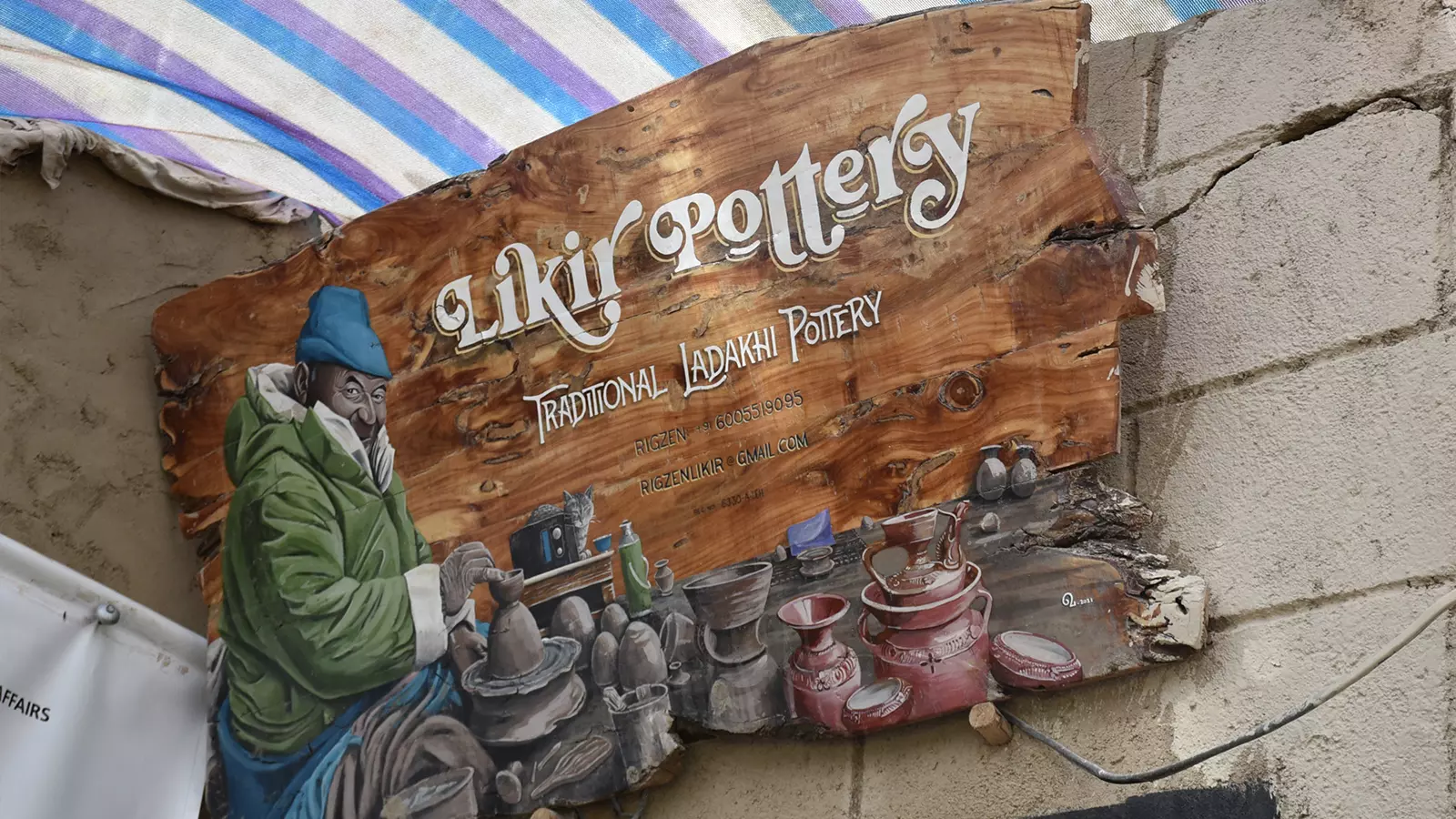
A seven-km ride from the National Highway, passing through some fields and brooks, takes one to the workshop of Ajang Tsepail (Ajang elder in Ladakhi), known as Likkir Pottery and Farm Stay. It is here that Tsephel can be found hard at work with his two sons and a few students.
When this reporter reached Likir, Tsephel was operating the skor (wheel), giving gentle strokes to the clay with zhema (a wooden tool for carvings on pottery), shaping an incense pot which is used in monasteries, especially during the Ladakhi New Year festival Losar.
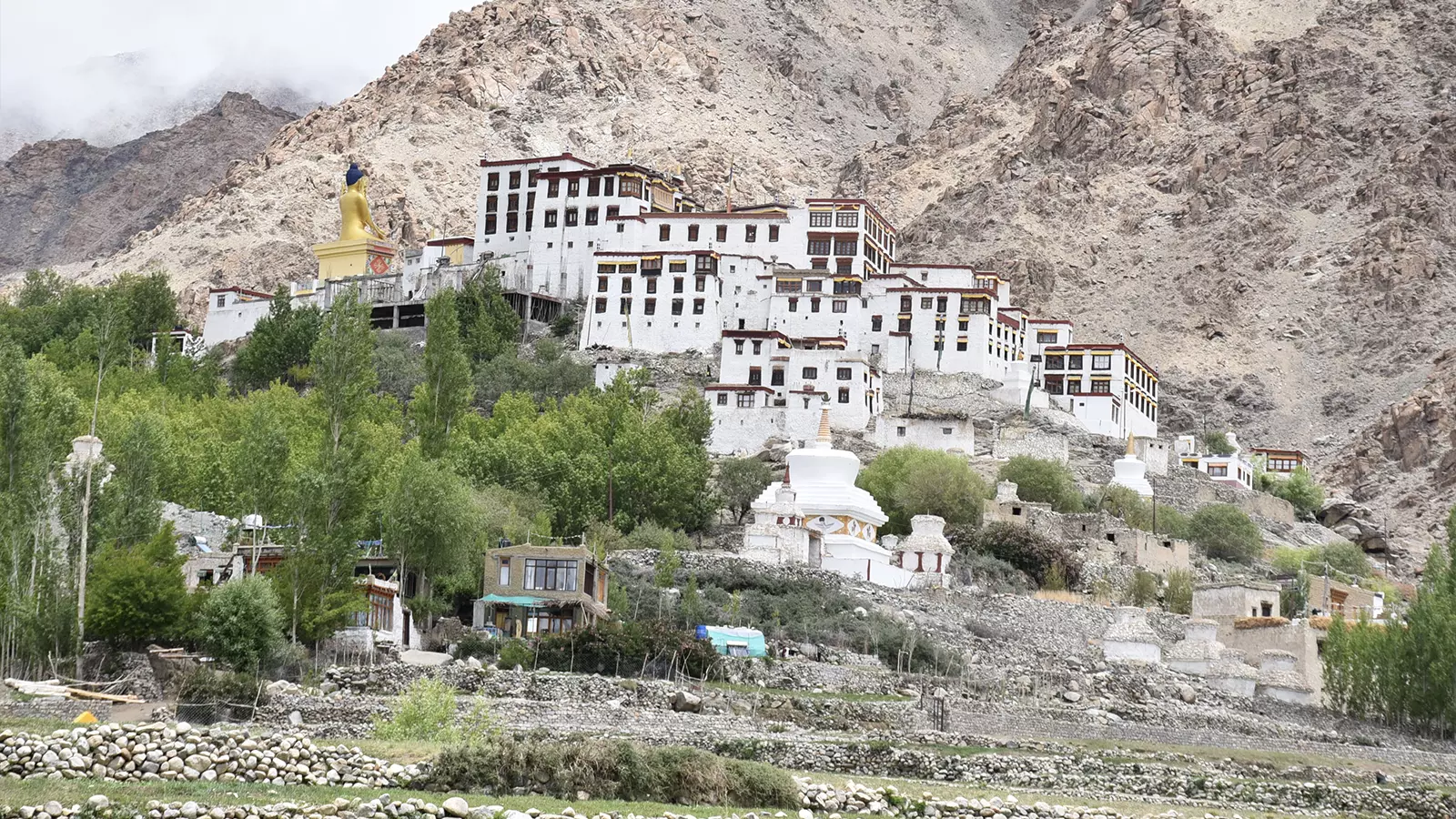
A view of the Likir Monastery.
According to local folklore, the people of Likir were assigned the job of making pottery by Ladakhi King Sonam Wangyal at a time when each village in Ladakh was given a particular responsibility. Likir, it is said, got the task of making pottery because of the good quality of clay available in the region. Over the years, Likir mastered pottery which developed into traditional art.
Learning pottery in Likir
Since the art has been traditionally passed on from one generation to the other, learning it wasn’t easy for Tsephel whose family was not into pottery. When Tsephel shared this idea with his mother, she was reluctant saying when his father never learned and practised the art, how would he master it. She was also concerned about how reliable it would be as a source of income.
Tsephel took the plunge nevertheless.
“I went to the mountain cliff from where clay is collected and loaded it on a donkey. I brought it to my workshop and made ten tipril (teapots). An elder living in the neighbourhood helped me in the firing of the clay and also taught me the details of pottery. Though the tiprils were not perfect, the excitement of creating a clay art was high,” Tsephel told The Federal.
Tsephel recounts that he bartered the pots for barley by going to various villages and was able to collect three tin cans of the grain for his clay pots. The initial journey was not easy, the hustle to perfect the art and to make a living out of it were challenges for the young boy.
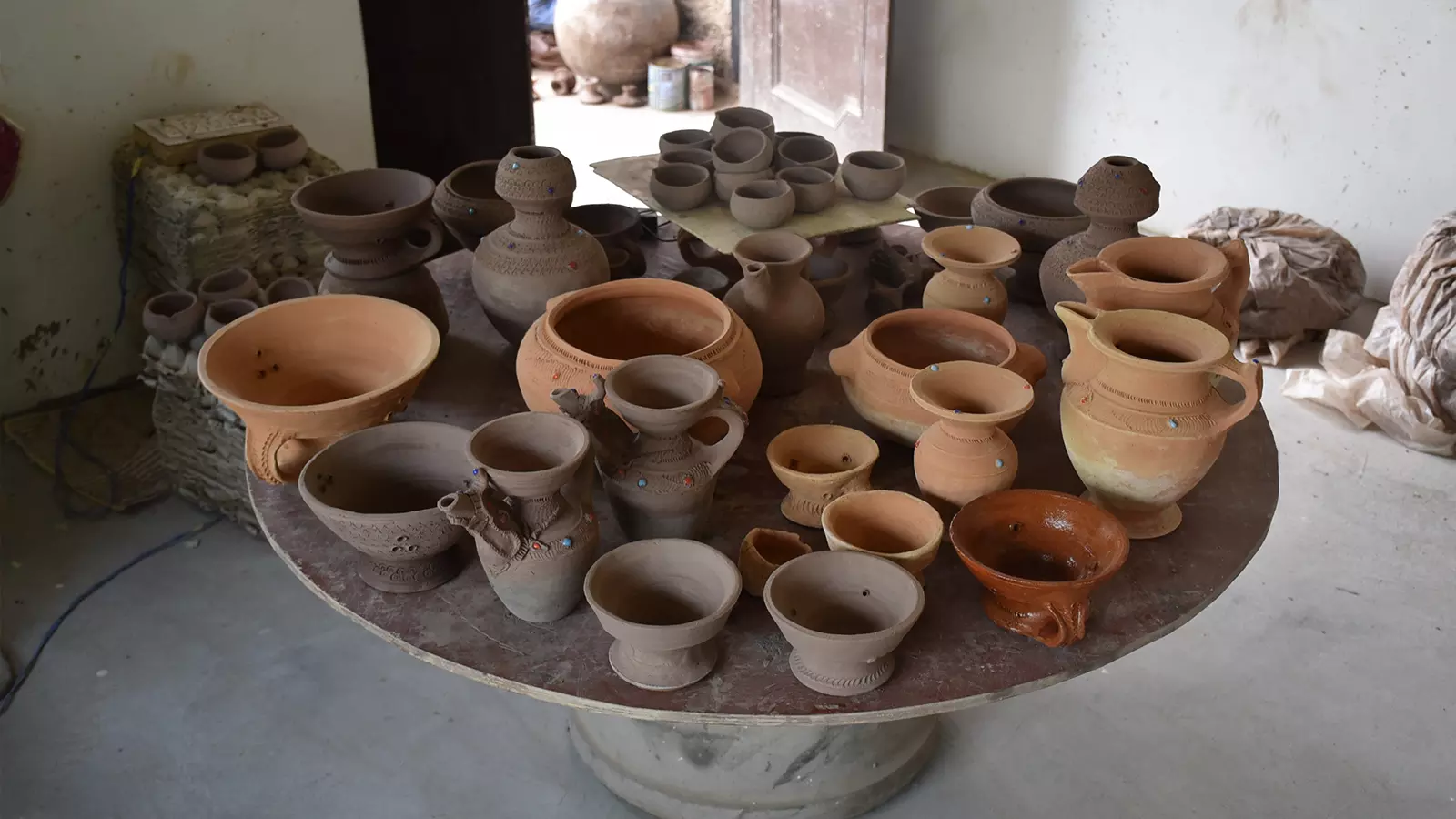
The clay work created by Lamchung Tsephel and his son Rigzen.
His tiprils had flawed bases and wouldn’t stand straight. After getting complaints regarding the tiprils, he again requested an elder potter to teach him. Those days, veteran potters were reluctant to teach. Tsephel, however, did not relent. He kept reaching out to elder potters for help and practised hard.
As days progressed, Tsephel understood the demands of the market and on the suggestion of a neighbour artist and sculptor bought machines for pottery and design making. He started making more sophisticated and visually appealing pots with a variety of designs and colourful patterns.
“When I started the work, pottery was only bought for regular use. Now, more often people buy it for decorative purposes and a sense of attachment to the earthy connections established through the soil,” he said.
As time passed, Tsephel’s son Rigzen also joined him in the pottery business.
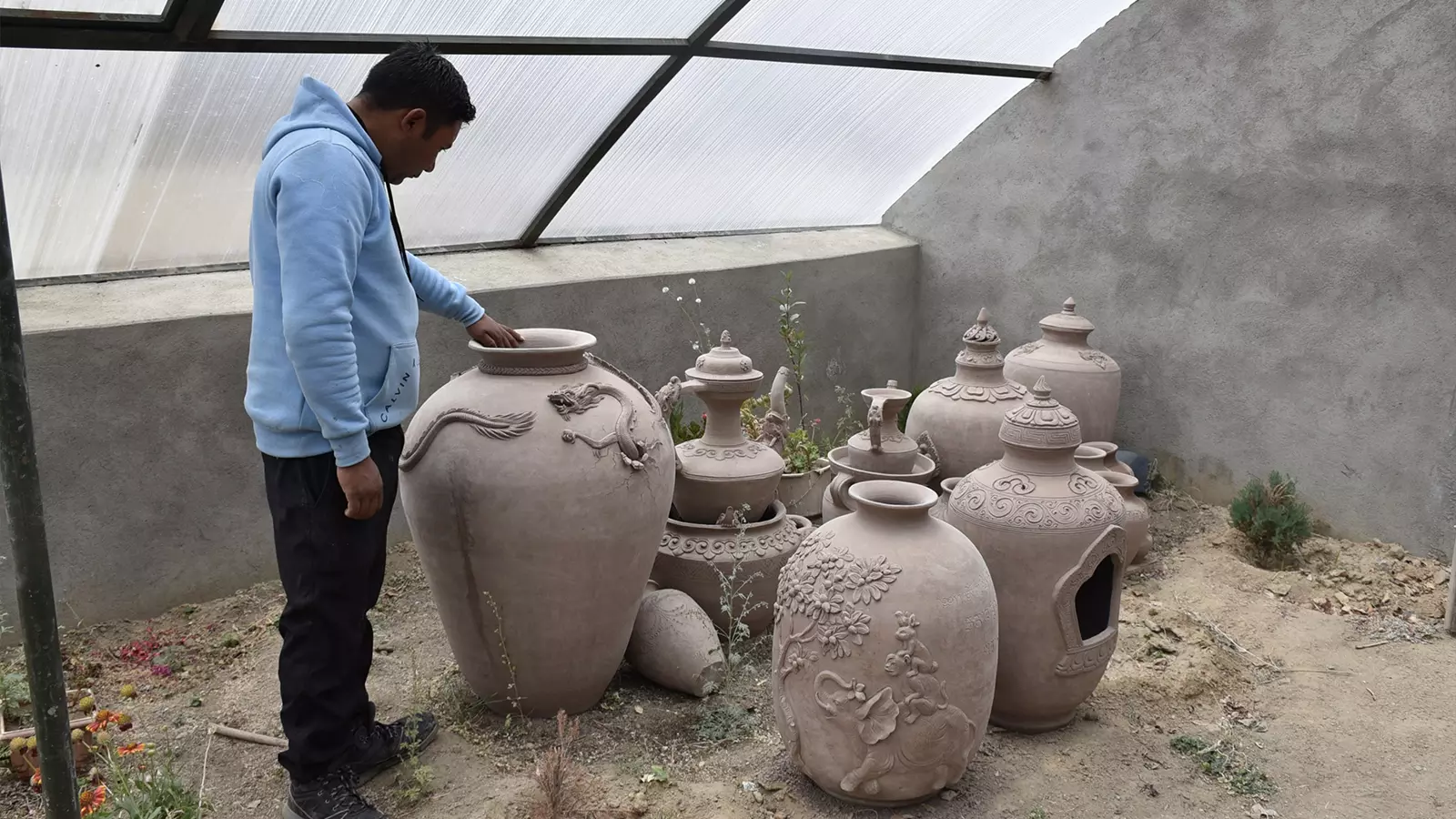
Rigzen Namgyal has taken Lamchung Tsephels work ahead in both scale and reach.
The neighbour artist and sculptor encouraged Tsephel and his son to make designs reflecting Ladakhi traditions and Buddhist philosophy on the teapots. The artist made the designs and paintings and the father-son duo would make the pottery, simultaneously learning design and painting both.
“The difference that I see in making pottery is that the products were not refined. Earlier, whatever we made was sold, but now people’s preferences have changed and as per the demand we make more artistic and refined products for decorative purposes,” Tsephel said.
Tea pots, incense pots, and beer containers have traditional importance embedded in Ladakhi culture, while decorative pieces and artefacts are also made these days considering the demand.
The art is decently rewarding too. A tipril earns nearly Rs 3,500. The family sells around 100-200 incense stick holders each year and each one costs around Rs 300. The oil lamp pots the most sought-after products selling around 5,000 pieces each year at about Rs 150 per piece.
Passing on the art
Mindful of the difficulty Tsephel had in looking for a teacher, he has been passing on his knowledge in pottery to hundreds of students from across India and overseas as well.
His teaching endeavours include collaboration on residency workshops with the National Institute of Design, where he is known by Ustad. The handicraft department also allotted a centre for him to teach the nuances of pottery to youths and artisans about. In the past two decades, many NGOs have collaborated with Tsephel and his son to conduct workshops on pottery production, and every year in peak season many tourists, both Indian and foreigners, visit his pottery workshop, learn from him, and also buy his products.
“I have taught hundreds of Indian and foreign tourists, it’s a responsibility for me to pass this rare Ladakhi art to the next generation,” Tsephel said.
A step ahead
In 2007, 17-year-old Rigzen after his Class 10th exams was trying to help his father in his work. This was the same time, awareness related to the use of clay pots was gaining traction in Ladakh and people were also understanding the cultural significance of it.
Rigzen, 36 now, credits his father for teaching him the details of Ladakhi pottery. But in his journey, he also credits people like Spon Tsering Dorje, a professional Thangka painter, who taught him to draw designs and paintings. A fellow artist Varun, who stayed with him for five years, made him understand the nuances of modern pottery, as he brought some modules and taught him the techniques of contemporary pottery.
In 2015, seeing Namgyal’s talent, a development practitioner from Leh, Sonam Safari, sent him to Manav Sangralaya in Madhya Pradesh, where he joined a one-month residency workshop on pottery and made Ladakhi pottery for the museum. His exposure and experimentation with other forms of pottery across the globe have given an edge to the pottery of Likir, the place that once used to produce simple pots and now produces the finest pieces of fine art.
Recounting his early days, Rigzen said that after seeing his talent, his father gave him a potter’s wheel and every day he would make two-three pottery products.
“One day my father offered me remuneration for the pottery I had made, it was a satisfying and memorable moment for me,” Rigzen said.
Rigzen has conducted various workshops in schools on Ladakhi pottery because he feels if this rare Ladakhi art is not passed on to the next generation, it will become extinct.
Sharing his struggle to learn the modern techniques, Rigzen said earlier everything was done manually right from picking the soil, beating it with a stick, making the perfect clay, and binding it with an equal proportion of sand. It took about 10 days to make the final product. However, with time and exposure, he now practices modern techniques of pottery and makes use of machines to make clay dough of clay and tries the products using fire through gas.
He added that in the rest of India, sand is not mixed in clay. It’s only in Ladakh that one-fourth portion of sand is mixed with one portion of clay because the region has less moisture in the air. The sand helps to reduce leakage.
Earlier, rice water and barley flour were kept for 10 days as per the local tradition to make the pottery tough but people nowadays have less patience.
Likkir Pottery has been supported by various institutions in the form of exposure visits and exhibitions outside of Ladakh. The government in Ladakh facilitated an exhibition at Delhi Haat, many NGOs helped to provide them platform, for exhibitions and workshops. Besides the Industries Department of Ladakh granted a subsidy loan to procure machinery, which has made Rigzen’s work easy.
“I am happy that I took this decision. Now, I realise why people were insisting I continue my father’s profession. Our pottery is valued across India and has helped us make good money,” Rigzen said.
Over the last two decades, Rigzen has taken Likkir Pottery to many states across the country through exhibitions and workshops. Many schools invite him to organise workshops for students, including the National Institute of Design.
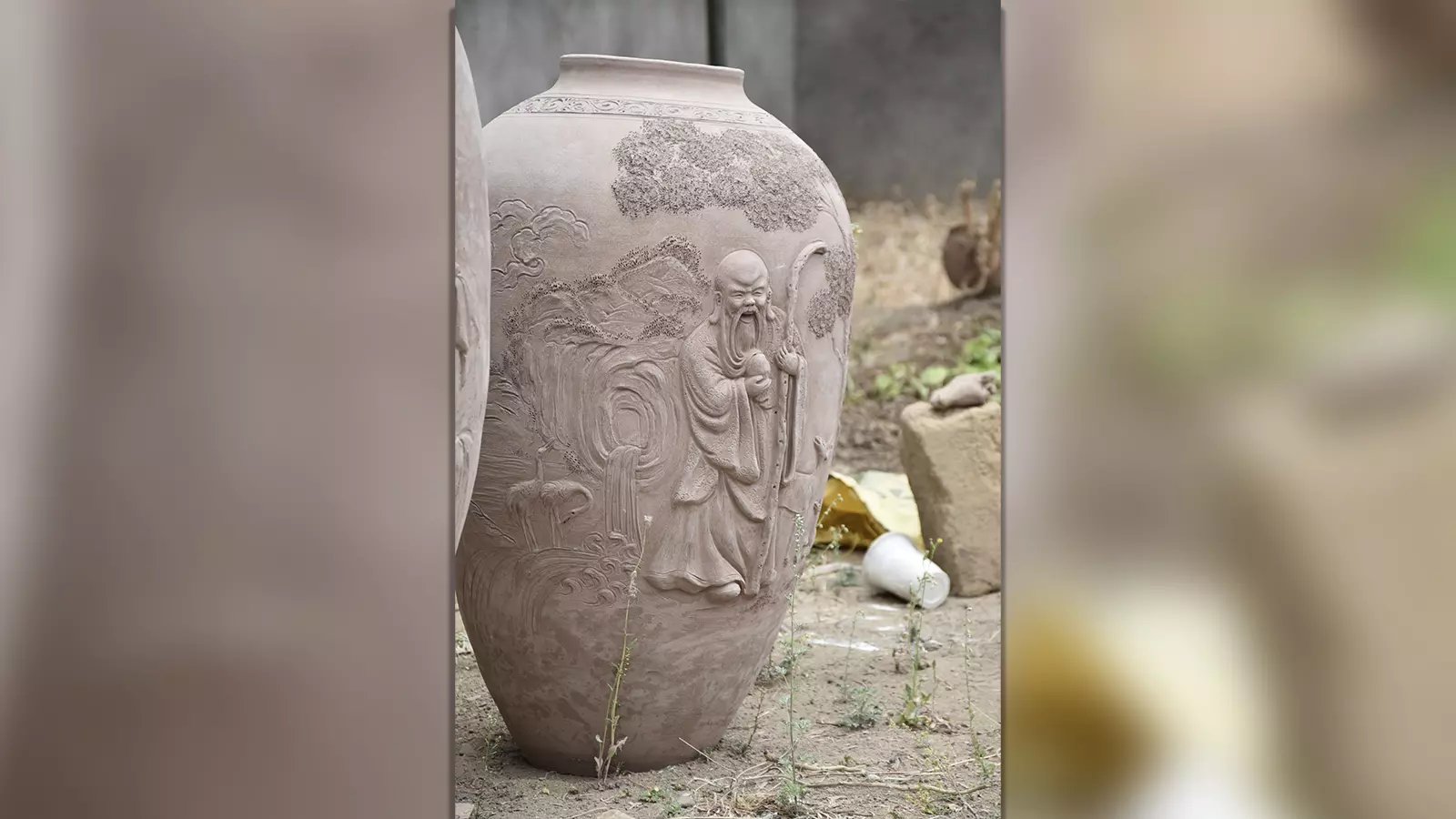
Buddhist art on pots.
Varun, a communication designer from Tamil Nadu, who has been staying with Rigzen and his family for over six years, to learn pottery, says the art is more than just creating pots.
“Initially, drawn to the potter family by my interest in clay and pottery, I discovered much more during my stay. I experienced a way of life in harmony with nature, starkly different from the exploitative, hyper-consuming society I was familiar with. Their generosity, kindness, and care for all beings are qualities I will never forget and always aspire to embody,” he said.
“I feel the beauty of Likir pottery lies in how local it is. The craft holds and keeps alive a deep understanding of the natural world that has been refined and passed down for generations,” he added.
He further shares that the clay, sand, cow dung, spung, raw materials for glaze, tools, and firing come from specific places in and around Likir. A really simple and well-designed hand-spun wheel that can be arranged anywhere. Each piece features unique forms for specific purposes and beautiful relief work on the wares. The firing technique, using a cow-dung kiln, is particularly remarkable, though it is now threatened by the declining number of cattle in the village and the availability of spung.
Lamchung Tsephel is happy that his son has managed to take the art a step ahead, and expand the work. The senior potter believes that this art should be taught to the youth and the government should take more initiatives.
“I remained committed to my work, and now people from across the world come to my village to see that pottery is alive in Ladakh,” Tsephel said wearing an expression of contentment.
